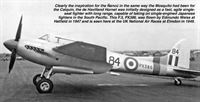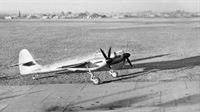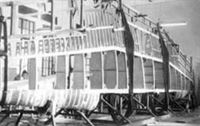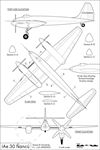Фотографии
-
Регистрационный номер: PX386 [2] Clearly the inspiration for the Nancu in the same way the Mosquito had been for the Calquin, the de Havilland Hornet was initially designed as a fast, agile singleseat fighter with long range, capable of taking on single-engined Japanese fighters in the South Pacific. This F.3, PX386, was flown by Edmundo Weiss at Hatfield in 1947 and is seen here at the UK National Air Races at Elmdon in 1949.
Самолёты на фотографии: De Havilland Hornet / Sea Hornet / D.H.103 - Великобритания - 1944
-
Регистрационный номер: PX386 [2] Edmundo Weiss (furthest right) with de Havilland personnel, including test pilot Geoffrey Pike (second from left), beside PX386 at the company’s airfield at Hatfield in 1947. Weiss was despatched to the UK to familiarise himself with various types of state-of-the-art fighters, particularly the Hornet, which would provide a good grounding for flying the Nancu.
Самолёты на фотографии: De Havilland Hornet / Sea Hornet / D.H.103 - Великобритания - 1944
-
The IAe.22 DL two-seat trainer was the first aircraft to be developed under the leadership of the Institute Aerotecnico’s Juan Ignacio San Martin. Powered by an indigenous lAe.16 El Gaucho nine-cylinder air-cooled radial engine, the first nationally designed aero-engine, the prototype made its first flight on May 25, 1943. Around 200 were built, the type seeing service with the Argentinian Air Force and Navy.
Самолёты на фотографии: FMA IAe.22 DL - Аргентина - 1944
-
At first glance looking very much like a radial-engined de Havilland Mosquito, to which it owed a clear design debt, the IAe.24 Calquin (Royal Eagle) was in fact slightly smaller, with a span of 16-3m (53ft 6in), as against the Mosquito’s 16-51m (54ft 2in), and a length of 12m (39ft 4in) to the British type’s 13-56m (44ft 6in). It was planned to put Merlins on the Calquin as the IAe.28, but the Nancu was developed instead.
Самолёты на фотографии: FMA IAe.24 Calquin - Аргентина - 1946
-
Showing its sleek lines and prominent nacelles housing its Rolls-Royce Merlin 130-series engines, the IAe.30 Nancu prototype is seen here at the lAe factory at Cordoba in central Argentina.
Самолёты на фотографии: FMA IAe.30 Namcu - Аргентина - 1948
-
The IAe.30's wing was a one-piece cantilever structure incorporating two spars. The wing’s taper was kept as sharp as possible to conserve the aircraft’s roll performance and the tip was squared to permit the aileron to extend outboard as far as possible, again to enhance roll quality. The control surfaces were metal-covered; Alclad ailerons and hydraulically-operated split flaps, divided by the engine nacelles, were fitted.
Самолёты на фотографии: FMA IAe.30 Namcu - Аргентина - 1948
-
The prototype with FAeA roundels added, but without its military serial, I-101, which was never applied to the aircraft. The glazed nose and long probe were fitted for the trials programme, but would have been replaced on production examples with a solid nose and a quartet of Hispano-Suiza 20mm cannon. Note also the radiator- and oil-cooler intakes in the wings inboard of the engines; the carburettor intakes were in the outer wings.
Самолёты на фотографии: FMA IAe.30 Namcu - Аргентина - 1948
-
A fine air-to-air study of the prototype over the Sierras Chicas mountains while up on a test flight from Cordoba. Of particular note in this view is the much higher-set tailplane of the Nancu compared to the Hornet, the tailplane of which was in a more conventional position at the base of the distinctive de Havilland fin.
Самолёты на фотографии: FMA IAe.30 Namcu - Аргентина - 1948
-
A view inside the slim and elegant “pear-shaped” curved-triangular-section fuselage of the prototype during construction. The structure was conventional, comprising alloy frames and top-hat-section stringers, to which the outer Alclad skin was riveted.
Самолёты на фотографии: FMA IAe.30 Namcu - Аргентина - 1948
-
Teniente Primero Edmundo Osvaldo Weiss (left) and Cesare Pallavicino pose for a photograph in front of the IAe.30 prototype. Having designed aircraft for Breda and Caproni in Italy before the war, Pallavicino co-designed the Lambretta motor scooter before emigrating to Argentina in 1946.
Самолёты на фотографии: FMA IAe.30 Namcu - Аргентина - 1948
-
The last remaining souvenir of the IAe.30 Nancu - a sectioned example of one of its two Rolls-Royce Merlin 130-series engines - remains on display at the Museo Universitario de Tecnologia Aeroespacial in Cordoba, along with a model of the aircraft.
Самолёты на фотографии: FMA IAe.30 Namcu - Аргентина - 1948
-
The prototype IAe.30 Nancu under construction in the IAe hangar at Cordoba in the second half of 1947. This aircraft reportedly took more than 370,000 manhours to build, but was completed in a remarkable 11 months.
Самолёты на фотографии: FMA IAe.30 Namcu - Аргентина - 1948
-
FMA I.Ae.30 Namcu мог бы стать великолепным боевым самолетом для ВВС Аргентины, по вооружению и летным данным превосходящим любой другой латиноамериканский самолет послевоенного периода. Но недостаток финансовых средств не позволил организовать его серийное производство.
On its return from Bolivia some modifications were made to the Nancu prototype. The original one-piece windscreen was replaced with a flat armoured front windscreen with two Perspex side panels. Aileron control was extremely heavy at high speeds and spring-tabs were fitted to provide improved lateral control at speeds up to the maximum permissible.Самолёты на фотографии: FMA IAe.30 Namcu - Аргентина - 1948
-
This side-view of the Nancu prototype, with later canopy, offers an interesting comparison with the Hornet, It highlights the Argentinian aircraft’s greater length - 11-51m (37ft 9in), not including the nose probe, as against the Hornet’s overall 10-82m (35ft 6in) - and the lack of dorsal fillet added to the Hornet’s shorter fin. The Nancu also had a greater span than its British counterpart - 14-94m (49ft) to the Hornet’s 13-7m (45ft).
Самолёты на фотографии: FMA IAe.30 Namcu - Аргентина - 1948
-
The prototype warms up at Cordoba for another test flight. Although the Nancu was unquestionably a promising design and a remarkable achievement for a relatively inexperienced industry, it was developed at a time when the future of fighters was inevitably jet-powered.
Самолёты на фотографии: FMA IAe.30 Namcu - Аргентина - 1948
-
The prototype in bare metal, with early canopy, soon after completion at the IAe factory at Cordoba. The prominent Merlin 130-series engines were designed as "slimline” variants with minimal frontal area specifically for the D.H.103 Hornet.
Самолёты на фотографии: FMA IAe.30 Namcu - Аргентина - 1948
-
A sad end for the sole Nancu - after Capitan Carlos Fermin Bergaglio’s landing accident in November 1951, the aircraft’s remains were dragged to a corner of the airfield at Cordoba and left to rot into the weeds before finally being scrapped.
Самолёты на фотографии: FMA IAe.30 Namcu - Аргентина - 1948
-
A full-scale mock-up of the production version of the IAe.30 in the hangar at Cordoba, incorporating design revisions including a solid nose, a lower-set tailplane and a dorsal fillet similar to that of the Hornet, plus a single-piece rudder and the reconfigured cockpit canopy.
Самолёты на фотографии: FMA IAe.30 Namcu - Аргентина - 1948
-
A 1/24-scale wooden model of the IAe.30 discovered by author Ricardo Lezon during a visit to Cordoba in 2013. It is not a windtunnel model, as no such testing was undertaken on the design, so it is thought to be a model of the prospective production version, with a solid nose, reshaped canopy, and with evidence that a dorsal fillet was also to be fitted.
Самолёты на фотографии: FMA IAe.30 Namcu - Аргентина - 1948
-
Самолёты на фотографии: FMA IAe.30 Namcu - Аргентина - 1948
Статьи
- -
- A.Arthy - Dieppe. The Luftwaffe Perspective
- A.Grandolini - On the wings of the Hansa (3)
- G.Smith - Pan Am's "Rogue" Atlantic Clippers
- K.Hayward - The Stop & Go Show
- K.Lande - Flash!
- L.Andersson - Turkish dismay
- L.Hellstrom - Sabena's Congo Ventilators
- M.Bearman - The other sound barrier
- N.Stroud - How quiet is our STOL?
- P.Davidson - Off the Beaten Track...
- P.Jarrett - Lost & Found
- R.Lezon, S.Rivas - The patagonian eagle
- T.Singfield - "A very nasty situation..."
- V.Flintham - Rover David (2)



















